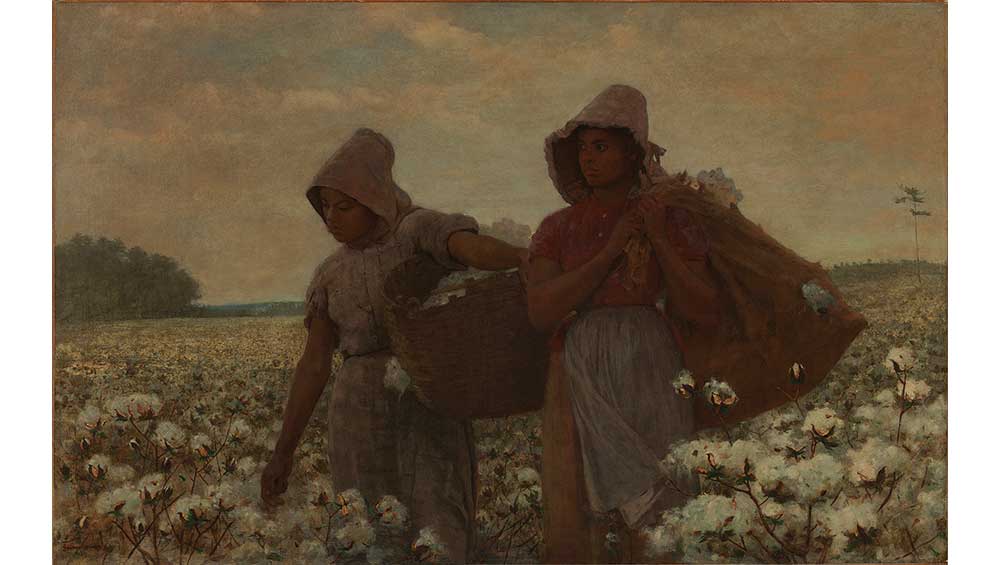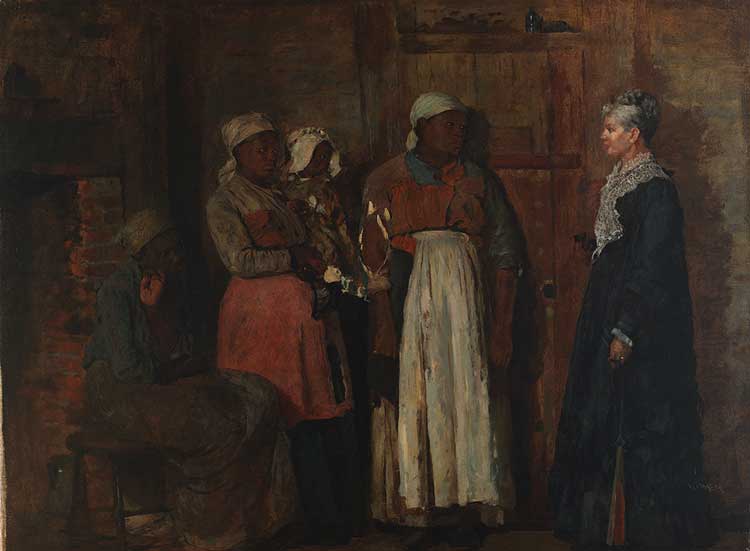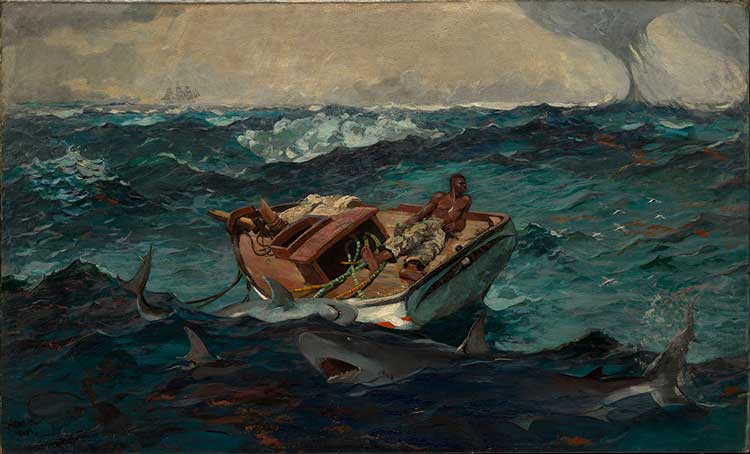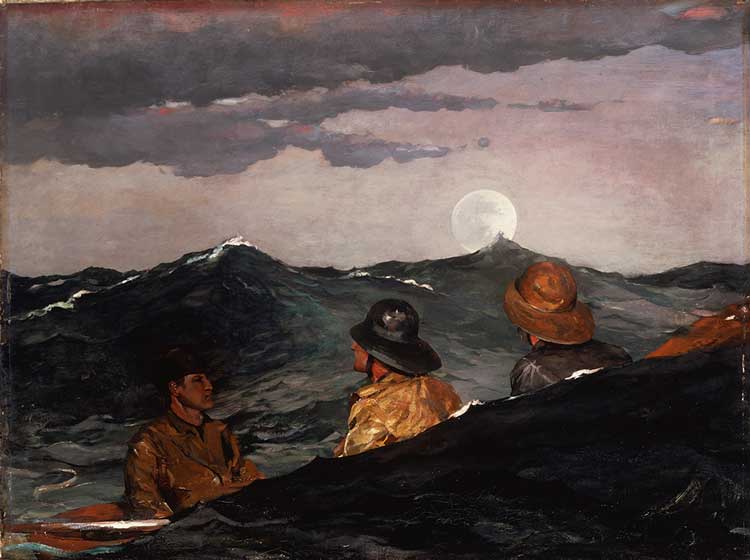
Winslow Homer. The Cotton Pickers, 1876. Oil on canvas, 61.2 x 96.8 cm. Los Angeles County Museum of Art, California. Acquisition made possible through Museum Trustees: Robert O. Anderson, R. Stanton Avery, B. Gerald Cantor, Edward W. Carter, Justin Dart, Charles E. Ducommun, Camilla Chandler Frost, Julian Ganz, Jr., Dr. Armand Hammer, Harry Lenart, Dr. Franklin D. M.77.68. © Los Angeles County Museum of Art, California.
The National Gallery, London
10 September 2022 – 8 January 2023
by TOM DENMAN
Winslow Homer’s The Cotton Pickers (1876), painted at the end of America’s so-called reconstruction era (1865-77), is as monumental as it is soft-edged. On one level, it fervently denies the harsh realities of black life in the rural south after the American civil war. Two women are standing in an endless field of cotton that reflects the cloudy, golden sky, as if the pickers were floating in a heavenly realm. For the sake of picturesque variety, one holds a basket, the other a bag, both brimming with the white abundance that frames them; one picks leisurely, while the other gazes into the distance, her apron blowing to evoke forward motion. Their poses hardly suggest the backbreaking labour of cotton picking. But the image is ambiguous. The abundance of cotton – in which they appear to be stranded – could also indicate that considerable progress has yet to be made. They are still working in the same job that they did when they were slaves, paid only subsistence wages. Such ambiguity is acted out on the face of the woman on the left. Her expression elicits defiance, distrust and disappointment, yet her facial features are also sweetly idealised.
Understanding the painting’s patronage complicates matters further. We don’t know the name of the man who bought it in 1877, before showing it at London’s Royal Academy of Arts the following year and introducing the British public to Homer’s work for the first time. But we do know he was an English cotton merchant who, as the wall text here explains, “presumably benefited financially from the economic exploitation of field workers both pre- and post-emancipation, as did the British economy throughout the war”. Thus, there is a strong and by no means unfounded temptation to view the picture in terms of ownership, profit and enclosure, as well as its libidinous appeal within this context; it might also have doubled up as a disingenuous signal of the owner’s virtue.
I linger on this picture because it encompasses some of the ambiguities that, among other things, make this exhibition so interesting. Homer (1836-1910) was a white painter invested in picturing the lives of emancipated black people. Most works in this show betray a genuine sympathy for their subject matter. In them, there is a recognisable aim to portray black lives in a manner that is neither ethnographic, exoticising, or stereotypical. And yet, despite the artist’s apparent good intentions, these were not unequivocally translated into cultural production. To use a cliche, Homer was a product of his times, although he also challenged them (we find literary counterparts to this conundrum in Herman Melville, Walt Whitman and Mark Twain). Paradox is evident even between works he created within close temporal proximity. Defiance: Inviting a Shot before Petersburg (1864) includes a black banjo player with the pink lips and expressionless eyes of a minstrel performer; whereas The Bright Side (1865) is a realist portrayal of four African American teamsters employed by the Union army, attesting to their agency in their own emancipation. These contradictions may be especially maddening to today’s viewer, and all the more so since Homer did not like to explain his work.

Winslow Homer. Visit from the Old Mistress, 1876. Oil on canvas, 45.7 x 61 cm. Smithsonian American Museum of Art, Washington, DC. Gift of William T. Evans. 1909.7.28. © Smithsonian Institution, Washington, DC.
Within a year of The Cotton Pickers, Homer painted two works whose emotional tenor and complexity, and their level of realism – in the formal and political sense – are far more sympathetic. In A Visit from the Old Mistress (1876), four free slaves are visited by the person who used to own them. The black figures pictorially overlap to form a unit apart from the white woman, an insular, shardlike triangle of muted tones. Intensifying the psychology of the standoff is the eye contact – previously forbidden between slaves and white people – between all four black women and their former mistress. The black figure nearest to us holds one hand awkwardly against her cheek, as if forcing herself to look at the intruder, while also protecting herself from Homer’s (and our) intrusive gaze. Dressing for the Carnival (1877), which depicts preparations for a Christmas celebration known as a Jonkonnu parade, could have veered towards the ethnographic taxonomising of “customs,” but Homer’s composition focuses on the mundane task of sewing the central figure’s multicoloured jacket. There is an everyday tenderness in the collective effort between the man wearing it, holding its front together, and the woman beside him drawing the thread.

Winslow Homer. The Gulf Stream, 1899 (reworked by 1906). Oil on canvas, 71.4 x 124.8 cm. The Metropolitan Museum of Art, New York. Catharine Lorillard Wolfe Collection, Wolfe Fund, 1906 06.1234. © The Metropolitan Museum of Art, New York.
In the exhibition’s centrepiece, The Gulf Stream (1899; reworked by 1906), a black man leans back on the deck of his boat, its mast and rudder broken, the ocean ferociously choppy and teeming with sharks. A red tinge on the water could be blood. The man is as determined to right the boat with his bodyweight while racking his brain for a solution, as he is resigned to the uncertainty of his predicament (it is said that remaining calm is the best way to deal with sharks). That Homer insisted the boatman was of no narratival consequence highlights the figure’s assimilation into the work’s aesthetic, to which he remains crucial. The painting draws on Romantic precedents to invent a kind of black sublime, combining the black body with its histories in a representation of agency, instability, unrest and fugitivity, as treacherously ambiguous as the ocean. Understood this way, The Gulf Stream is at once a work of aesthetic co-option and a powerful visualisation of black history. It shares a room with other works, mainly watercolours, which reflect Homer’s fascination with Florida and the Caribbean. But in most of these, by reducing the black inhabitants to atmospheric tropes, Homer creates a touristic illusion of tropical tranquillity. Here, the assimilation of black bodies into an equatorial picturesque whitewashes the cruelties of the black Atlantic.

Winslow Homer. The Fog Warning (Halibut Fishing), 1885. Oil on canvas, 76.8 x 123.2 cm. © Museum of Fine Arts, Boston. Anonymous gift with credit to the Otis orcross Fund, 94.72.
Homer’s explorations of race in post-civil war America are fundamental to his historical significance as an artist, with strong implications for today’s cultural climate, especially the artworld, which in recent years has brought race to the fore as a discourse to be engaged with and represented. One of the key takeaways from this show is that radical change was as hard-won then as it is now, even if the intentions of those pushing for it were seemingly sound. But Homer’s works – and this exhibition – are not all about race. His most exciting formal experiments are in his depictions of turbulent sea, especially when the water is less a backdrop or surface, or even an object of wondrous contemplation, than an active, unruly presence that threatens to dominate both figures and pictorial space. Works such as The Fog Warning (Halibut Fishing) (1885) and The Herring Net (1885) annihilate the vantage point of, say, JMW Turner’s storms. The water’s movement shapes the composition as if it were beyond the painter’s control. As such, it also determines our perspective: we, too, are at sea, losing our footing, maybe feeling seasick. In these works, our engagement with the environment is less Romantic than tactical. Nature engulfs, forbidding us from contemplating its wonders. We must experience it at sea level.

Winslow Homer. Kissing the Moon, 1904. Oil on canvas, 76.8 x 101.6 cm. Addison Gallery of American Art, Phillips Academy, Andover, Massachusetts. Bequest of Candace C. Stimson, 1946.19. © Addison Gallery of American Art, Phillips Academy, Andover, Massachusetts.
Even still, contemplation might present itself fleetingly, to be continued afterwards as a memory, or in the alternate dimension of art. Homer’s late painting Kissing the Moon (1904) further brings out his fascination with how the environment jolts our perspective. As controlled as his execution might be, there is a sense of accident as the crest of one of the waves touches the moon; a sense that the artist is trying to hold the frame still but can’t, that he wants to capture that one recurring moment at all costs. Or perhaps it’s the three men in the boat – and the boat – he wants to depict. Either way, the motion of the water dictates the composition. But of course, this isn’t really true, because this is a painting, not a photograph, most likely executed in his studio on Prouts Neck in Maine. Homer’s skill is to recreate the contingency of being beholden to the elements. We can’t tell what the boatmen are thinking; they sit stiffly, as if oblivious to the water banking around them. Yet the one closest to us – we only see the back of his head, but it is at just the right angle to make us instinctively project our own viewpoint on to his – might be looking at the very thing, that moment, that gave the picture its title. Again, ambiguity prevails.